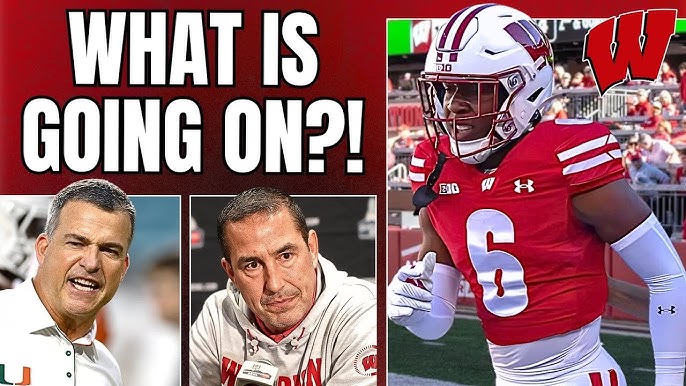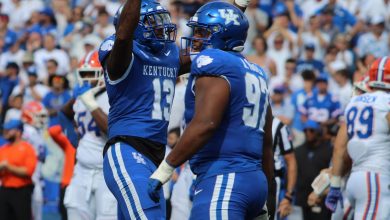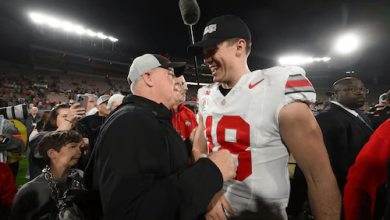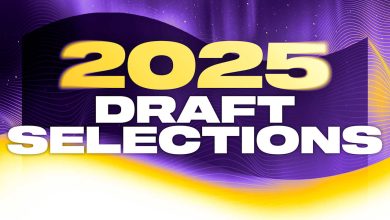To what extent does this Miami, Wisconsin, NIL issue matter?

The issue of Name, Image, and Likeness (NIL) rights in college athletics has become one of the most significant and controversial topics in recent years. In particular, the debate has gained even more traction following the introduction of NIL in 2021, which allows college athletes to profit from their personal brands, endorsements, and other commercial ventures. While the policy was initially welcomed as a step toward fairness and economic empowerment for athletes, it has also led to unintended consequences, particularly in the realm of competitive balance and recruitment. The ongoing controversy surrounding the University of Miami (Miami Hurricanes) and the University of Wisconsin (Wisconsin Badgers) in relation to NIL deals highlights the complexities and potential pitfalls of this new reality in college sports.
The Rise of NIL and Its Impact on College Sports
Before delving into the specifics of the Miami and Wisconsin NIL issue, it’s important to understand the broader context of NIL in college athletics. For decades, college athletes were prohibited from receiving any form of compensation beyond their scholarships, leading to widespread criticism and calls for reform. Athletes, often the central figures in generating millions of dollars in revenue for their schools and the NCAA, were unable to receive any direct financial benefit from their talents. This system was upheld by the NCAA for years, with a strict amateurism policy.
However, after years of pressure from athletes, lawmakers, and advocacy groups, the NCAA officially adopted an NIL policy in July 2021. This policy allows athletes to enter into sponsorships, sign endorsement deals, and receive compensation for their name, image, and likeness. Although the policy was hailed as a victory for athletes, it also introduced new challenges, particularly concerning the inequitable distribution of NIL deals among schools and athletes, and the potential for NIL to influence recruitment and player retention.
As schools, boosters, and third-party organizations began to invest heavily in NIL opportunities, certain programs saw significant advantages in attracting high-profile athletes. Powerhouse programs with deep-pocketed donors and alumni networks—like the University of Miami—appeared to be well-positioned to take advantage of the new landscape. Meanwhile, programs with fewer financial resources or less established NIL infrastructure, like Wisconsin, faced challenges in adapting to the new reality.
Miami’s NIL Position: A Powerhouse in the Making
The University of Miami has been one of the most prominent schools in embracing NIL since its implementation. Miami, with its rich history in football and basketball, has been a powerful force in recruiting top-tier athletes in the past. However, with the introduction of NIL, the Hurricanes have found new ways to leverage the policy to their advantage.
Miami’s NIL success is largely attributed to its innovative partnerships with prominent local businesses and wealthy boosters. The Miami NIL initiative, led by the “The U” Collective, has made waves in the college sports world by offering athletes substantial endorsement opportunities. Boosters and local companies, eager to see their brand associated with Miami’s athletic prowess, have worked together to secure endorsement deals for multiple athletes across different sports. The school has been aggressive in creating a strong infrastructure for NIL opportunities, offering athletes the chance to profit from their personal brand through appearances, social media endorsements, and corporate sponsorships.
In 2021 and 2022, Miami emerged as one of the schools that seemed most willing to push the boundaries of NIL. For example, when the Hurricanes landed high-profile players like basketball’s Isaiah Wong and football’s Tyrique Stevenson, the deals involved appeared to include generous NIL compensation, especially in comparison to schools without similar resources. In 2022, Miami was one of the first schools to use its NIL program to pay athletes directly, with commitments in the six-figure range for star players.
Miami’s aggressive approach to NIL has drawn scrutiny from other programs, particularly those at schools with fewer financial resources or less enthusiastic booster involvement. This situation has led to significant concerns about the creation of an uneven playing field in recruiting and a potential rise in what some have referred to as “pay-for-play” systems. With schools like Miami leading the charge in NIL deals, the program has found itself at the center of this debate.
Wisconsin’s Struggles with NIL
In contrast, the University of Wisconsin has faced challenges in competing with NIL-empowered programs like Miami. While Wisconsin has traditionally been a competitive force in college athletics, particularly in football, the university has lagged in terms of NIL infrastructure and opportunities.
Wisconsin, located in the heart of the Midwest, has a strong academic reputation and passionate sports fans, but it has not historically been known for its wealth of alumni or donors who could funnel large sums of money into the NIL market. As a result, Wisconsin has faced an uphill battle in attracting recruits when compared to schools like Miami, who have been more proactive in using NIL deals to enhance their recruiting efforts.
The lack of NIL opportunities at Wisconsin has become an increasingly significant issue in recent years. For example, some recruits have expressed concerns about the lack of NIL compensation available in Madison, leading them to consider other programs with more robust offerings. In football, Wisconsin has faced difficulties in attracting top-tier players in positions like quarterback or wide receiver, where schools like Miami have excelled by offering large NIL deals to blue-chip prospects.
One of the primary reasons for Wisconsin’s struggles with NIL is its more traditional, Midwestern approach to college athletics. Unlike schools in Florida or Texas, which have vast business networks and deep-pocketed donors, Wisconsin has historically been less reliant on the commercial side of college sports. While this approach has worked for the Badgers in the past, it has now become a disadvantage in the NIL era.
The Miami-Wisconsin NIL Issue: Competitive Imbalance and Ethical Concerns
The Miami and Wisconsin NIL issue illustrates a broader concern within college sports: the potential for NIL to create a competitive imbalance among programs. Schools with significant financial backing—either from wealthy boosters, large alumni networks, or strong local businesses—are poised to dominate the NIL landscape. Meanwhile, programs with fewer resources are left at a disadvantage.
This imbalance raises ethical concerns about the future of college athletics. The introduction of NIL was intended to give athletes the ability to profit from their names and brands without necessarily turning college sports into a professional system. However, the concern is that NIL could lead to the “professionalization” of college sports, where players are essentially bought and sold based on the highest bidder, leading to a further concentration of power in certain schools and conferences. Programs like Miami, which have the infrastructure and financial backing to offer large NIL deals, are now able to attract top talent at a level that schools like Wisconsin may find difficult to compete with.
This issue has sparked debate on a number of fronts. Some argue that NIL deals are simply a natural evolution of the system, where the market dictates the value of a player’s name and likeness. In this view, Miami’s ability to secure large NIL deals is just a reflection of the program’s success in creating a dynamic and appealing environment for recruits. Others, however, contend that this unregulated market undermines the principle of fair competition in college sports, creating a situation where the wealthiest programs have an unfair advantage in recruiting.
The Role of the NCAA and Future Reforms
The NCAA has largely left the regulation of NIL deals to individual schools and states, which has contributed to the lack of uniformity across the country. While some states have implemented NIL legislation, others have been slow to follow suit, leading to discrepancies in how deals are structured and enforced. The NCAA, meanwhile, has struggled to find a clear solution to the challenges posed by NIL, especially as the issue of competitive imbalance continues to grow.
As a result, there have been calls for greater oversight and reform of the NIL landscape. Some have proposed creating a nationwide standard for NIL deals, which would ensure more equity across schools and states. Others argue that NIL deals should be subject to certain limitations to prevent schools from using them as a recruiting tool to lure top athletes away from smaller programs.
In particular, the issue between Miami and Wisconsin could prompt discussions about how to regulate NIL deals in a way that promotes fairness while still allowing athletes to benefit from their personal brands. Schools like Wisconsin may need to invest more in NIL opportunities to remain competitive, while programs like Miami will likely continue to push the boundaries of what is possible under the current system.









